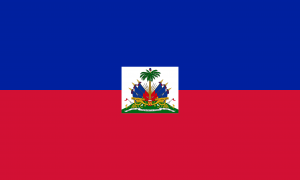Language/Haitian/Culture/Haitian-Painters
| ◀️ Haitian Holidays — Previous Lesson | Next Lesson — Haitian Music Styles ▶️ |
Welcome to this lesson on Haitian painters! As part of our exploration of Haitian art and music, we will take a closer look at some of the most renowned painters the country has produced. Haiti has a vibrant tradition of painting that dates back to the early 20th century. For many years, Haitian painters were known mainly for their depictions of Haitian daily life and religious imagery. However, as Haitian art has gained prominence and influence around the world, Haitian artists have been able to explore more abstract and personal themes in their work.
Take some time to dive into these other pages after completing this lesson: Haitian Geography & Haitian Holidays.
Hector Hyppolite
One of the most famous Haitian artists is Hector Hyppolite (1894-1948). Hyppolite is often considered the father of Haitian painting. He only started painting in his forties but quickly gained recognition for his striking and colorful works. He was a self-taught artist who painted mainly on canvas or pieces of fabric. His work was very influential and helped to establish Haitian art as an important and unique form of artistic expression. Many of his paintings depict Haitian voodoo scenes, which are very colorful and full of energy.
Let's take a look at some of his most famous works:
| Haitian | Pronunciation | English |
|---|---|---|
| Béra | bɛʀa | Berry |
| Ti-Jean Petro Dansant | ti ʒɑ̃ petʀo dɑ̃sɑ̃ | Ti-Jean Petro Dancing |
| Grand Bois | gʀɑ̃ bwɑ | Big Woods |
Notice how Hyppolite incorporated Haitian culture and religious imagery into his paintings. The vibrant colors and intense energy of his works continue to captivate viewers around the world.
Philomé Obin
Another important Haitian painter is Philomé Obin (1891-1986). Obin was a farmer and a politician who started painting in his seventies. His work is very different from Hyppolite's. Rather than focusing on voodoo and mysticism, Obin painted historical scenes and landscapes. His works are more subdued and muted, but they are still very powerful.
Let's take a look at some of his most famous works:
| Haitian | Pronunciation | English |
|---|---|---|
| La Pêche au Sel | la pɛʃ o sɛl | Fishing for Salt |
| Le Général Toussaint Louverture | lə ʒeneʀal tuˈsɛ̃tuviʁtʃyʀ | General Toussaint Louverture |
| Le Marché de Port-au-Prince | lə maʁʃe də pɔʁ to pʁɛ̃s | Port-au-Prince Market |
Obin's commitment to documenting Haitian history through his paintings made him an important figure in Haitian cultural life. His works can be seen in museums and galleries around the world, and continue to inspire artists in Haiti and beyond.
Conclusion
In this lesson, we have learned about two of the most important Haitian painters of the 20th century: Hector Hyppolite and Philomé Obin. We explored their unique styles and how they captured different aspects of Haitian life and culture in their works. Haitian painting continues to be a vibrant and dynamic art form that reflects the creativity and energy of the country and its people.
Thank you for studying with us today!
Upon wrapping up this lesson, take a look at these related pages: Haitian Music Styles & Haiti Timeline.
Videos
Haitian Art: "Buried but not Dead" - YouTube
Haitian Art Exhibit - YouTube
Other Lessons
- Haitian Dance
- Haitian Holidays
- Haiti Timeline
- Haitian Independence
- Haitian Music Styles
- Haitian Geography
Sources
| ◀️ Haitian Holidays — Previous Lesson | Next Lesson — Haitian Music Styles ▶️ |

